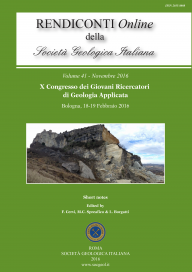
Multivariate Statistical approach vs. Deterministic physically based model for landslide susceptibility assessment
Giovanni Francesco Finicelli (a), Pierluigi Confuorto (a), Maria Teresa Carratù (a) & Diego Di Martire (a)
(a) Department of Earth Sciences, Environment and Resources , Federico II University of Napoli, Largo San Marcellino, 10, 80138, Napoli, Italy. E-mail: giovannifrancesco.finicelli@unina.it
Volume: 41/2016
Pages: 151-154
Abstract
We present a comparison between the results of two landslide susceptibility analyses approaches: multivariate (Logistic Regression) and deterministic–physically based (SHALSTAB). In order to assess the Landslide Susceptibiliy Index, five different predisposing factors to landslide occurrence (slope, aspect, land cover, distance to streams and rocky scarps) for the first one and material density, material friction angle, material hydraulic transmissivity, bulk cohesion and depth to potential shear plane for the second have been set up respectively.
Two different sectors of the urban area of the Phlegraean Fields, within the municipalities of Naples and Pozzuoli, have been selected for the application of the two methodologies: the Agnano Plain hillslopes (slope maximum elevation: 190 m a.s.l.) and the Astroni volcano (max. elev.: 253 m a.s.l.). The results have been compared and tested (ROC/AUC curves) allowing further considerations about the benefits and the constraints of each model.
Keywords
Get Full Text